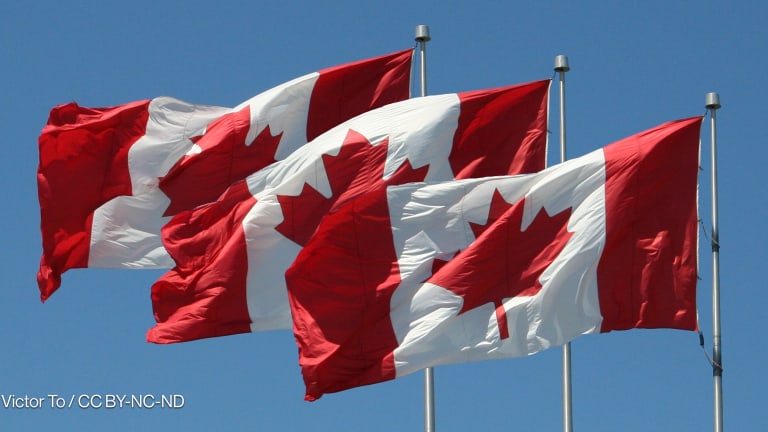Interactive: Who won USAID’s local contracts in 2023?
Local contracts in 2023 accounted for just 3.2% of the total acquisition — down from last year and far from USAID's 25% goal.
The U.S. Agency for International Development is inching closer to its self-imposed deadline for one of its key localization goals — that by 2025, 25% of its funding would go to local partners. While the definition of what local entails or how it should be measured varies among organizations that track USAID’s progress, many seem to arrive at the conclusion that it would take a Herculean effort for the agency to meet its target. In this article, as with our previous analyses, we count a supplier as local if they operate within the same country as the activities they are implementing. Following our previous report on USAID’s local spending through assistance, we now turned our attention to its other primary funding mechanism: acquisition. According to USAID’s latest annual progress report, it spent around $38 billion through assistance and acquisition, or A&A, in the fiscal year that ended in September 2023. Around $6.8 billion of the total was obligated through contracts. But what portion of these contracts got into the hands of local organizations? Who among them received the biggest share? And what for? We looked into the data from USASpending to get the answers. The portal is updated regularly, which may explain any slight differences in figures from this article. Where does USAID stand on its localization targets? As mentioned, USAID obligated around $6.8 billion in 2023 — a 9.5% real-term increase from the previous fiscal year. Our findings show that despite this rise, the dollar amount that went to local contractors still dipped by almost a quarter — from $288.3 million to $218.9 million. In percentages, the amount that went to local organizations represents 3.2% of USAID’s total obligation via contracts — a 1.5-point reduction from what local contractors received in the previous fiscal year. If we add this to our estimate of 8% local grants and cooperative agreements, the number stands at around 6.6% of A&A going to local recipients — way off the 25% mark. Meanwhile, another $36.2 million was awarded to low- and middle-income countries-based suppliers for activities in another country — a substantial jump from the $2.3 million this group of suppliers received in the previous year. Overall, the largest portion of the total, worth nearly $6.5 billion, still went to U.S.-based contractors. What’s the breakdown of local contracts? Local suppliers from low-income countries won more than half of the total, worth $112.4 million. This is 12.5% more than what the same cohort received in 2022. Contractors from lower-middle-income countries ranked next, with $87.8 million, down 24% from the previous fiscal year. The remaining, worth $18.8 million, went to receipients from upper-middle-income countries. This is down 74.2% from what suppliers from this bracket received in 2022. Sub-Saharan Africa remains the top supplier region despite a 19.3% real-term drop from what it received in the previous fiscal year. Contractors from the region won $192.2 million, or 87.8% of the total in 2023. South Asia ranked next, with $9.3 million — a 153.7% increase from the previous fiscal year. The rest went to Latin America and Caribbean, worth $4.4 million, Europe and Central Asia, worth $3 million, and East Asia and Pacific, worth $952.1 million. Among supplier countries, Uganda was the top recipient, with $60.9 million — 27.8% of the total and a 9.3% increase from 2022. Zambia ranked next, with $32.5 million; Mozambique, with $22.1 million; Tanzania, with $18.9 million; and Rwanda, with $15.2 million. Overall, 29 countries saw an increase in their total obligation between 2022 and 2023, with their cumulative gain amounting to $30 million. The opposite was experienced by 25 countries, which incurred a $99.4 million reduction in their total obligation in 2023. <div class='tableauPlaceholder' id='viz1722326512630' style='position: relative'><noscript><a href='#'><img alt='Geographical breakdown of USAID local contracts in FY23 ' src='https://public.tableau.com/static/images/Ge/GeographicalbreakdownofUSAIDlocalcontractsinFY23/GeographicalbreakdownofUSAIDlocalcontractsinFY23/1_rss.png' style='border: none' /></a></noscript><object class='tableauViz' style='display:none;'><param name='host_url' value='https%3A%2F%2Fpublic.tableau.com%2F' /> <param name='embed_code_version' value='3' /> <param name='site_root' value='' /><param name='name' value='GeographicalbreakdownofUSAIDlocalcontractsinFY23/GeographicalbreakdownofUSAIDlocalcontractsinFY23' /><param name='tabs' value='no' /><param name='toolbar' value='yes' /><param name='static_image' value='https://public.tableau.com/static/images/Ge/GeographicalbreakdownofUSAIDlocalcontractsinFY23/GeographicalbreakdownofUSAIDlocalcontractsinFY23/1.png' /> <param name='animate_transition' value='yes' /><param name='display_static_image' value='yes' /><param name='display_spinner' value='yes' /><param name='display_overlay' value='yes' /><param name='display_count' value='yes' /><param name='language' value='en-US' /><param name='filter' value='publish=yes' /><param name='showShareOptions' value='false' /></object></div> <script type='text/javascript'> var divElement = document.getElementById('viz1722326512630'); var vizElement = divElement.getElementsByTagName('object')[0]; if ( divElement.offsetWidth > 800 ) { vizElement.style.width='580px';vizElement.style.minHeight='877px';vizElement.style.maxHeight='1507px';vizElement.style.height=(divElement.offsetWidth*0.75)+'px';} else if ( divElement.offsetWidth > 500 ) { vizElement.style.width='580px';vizElement.style.minHeight='877px';vizElement.style.maxHeight='1507px';vizElement.style.height=(divElement.offsetWidth*0.75)+'px';} else { vizElement.style.width='100%';vizElement.style.height='1077px';} var scriptElement = document.createElement('script'); scriptElement.src = 'https://public.tableau.com/javascripts/api/viz_v1.js'; vizElement.parentNode.insertBefore(scriptElement, vizElement); </script> <i style=font-style: georgia;”>Geographical breakdown of USAID local contracts in 2023, based on USASpending.</i> Who were the top local suppliers? Based on our analysis, USAID partnered with around 350 local recipients in LMICs in 2023. Among them, 86 local suppliers received more funding in 2023 than in 2022. Their total gain amounted to $48.8 million Meanwhile, 124 local suppliers recorded a cumulative dip of $142.9 million from the previous fiscal year. Eight of the top contractors in 2022 are also part of the current list. Green Label Services and Access to Health Zambia replaced Vina E&C Investment and Construction and John Snow Health Zambia. Nine of the top 10 local contractors are nonprofits, with Rwanda Medical Supply being the only state-owned enterprise. Among the top suppliers, Joint Medical Store received the largest share, worth $31.2 million, or twice its previous total obligation. The Ugandan health commodity giant climbed six notches from 2022. JMS’s biggest activity, worth $20.5 million, was for the purchase and delivery of test kits and antiretroviral drugs for HIV patients with syphilis. Right to Care Zambia ranked next, with $24.9 million for the treatment and control of HIV. Deloitte Tanzania is also among the top suppliers, receiving $18.9 million for HIV and TB program. <div class='tableauPlaceholder' id='viz1722331327162' style='position: relative'><noscript><a href='#'><img alt='Dashboard 1 ' src='https://public.tableau.com/static/images/Lo/LocalrecipientsofUSAIDcontractsinFY23/Dashboard1/1_rss.png' style='border: none' /></a></noscript><object class='tableauViz' style='display:none;'><param name='host_url' value='https%3A%2F%2Fpublic.tableau.com%2F' /> <param name='embed_code_version' value='3' /> <param name='site_root' value='' /><param name='name' value='LocalrecipientsofUSAIDcontractsinFY23/Dashboard1' /><param name='tabs' value='no' /><param name='toolbar' value='yes' /><param name='static_image' value='https://public.tableau.com/static/images/Lo/LocalrecipientsofUSAIDcontractsinFY23/Dashboard1/1.png' /> <param name='animate_transition' value='yes' /><param name='display_static_image' value='yes' /><param name='display_spinner' value='yes' /><param name='display_overlay' value='yes' /><param name='display_count' value='yes' /><param name='language' value='en-US' /><param name='filter' value='publish=yes' /><param name='showShareOptions' value='false' /></object></div> <script type='text/javascript'> var divElement = document.getElementById('viz1722331327162'); var vizElement = divElement.getElementsByTagName('object')[0]; if ( divElement.offsetWidth > 800 ) { vizElement.style.width='580px';vizElement.style.minHeight='877px';vizElement.style.maxHeight='1507px';vizElement.style.height=(divElement.offsetWidth*0.75)+'px';} else if ( divElement.offsetWidth > 500 ) { vizElement.style.width='580px';vizElement.style.minHeight='877px';vizElement.style.maxHeight='1507px';vizElement.style.height=(divElement.offsetWidth*0.75)+'px';} else { vizElement.style.width='100%';vizElement.style.height='1027px';} var scriptElement = document.createElement('script'); scriptElement.src = 'https://public.tableau.com/javascripts/api/viz_v1.js'; vizElement.parentNode.insertBefore(scriptElement, vizElement); </script> <i style=font-style: georgia;”>Top local recipients of USAID contracts in 2023, based on USASpending.</i> Try out Devex Pro Funding today with a free five-day trial, and explore funding opportunities from over 850 sources in addition to our analysis and news content.
The U.S. Agency for International Development is inching closer to its self-imposed deadline for one of its key localization goals — that by 2025, 25% of its funding would go to local partners.
While the definition of what local entails or how it should be measured varies among organizations that track USAID’s progress, many seem to arrive at the conclusion that it would take a Herculean effort for the agency to meet its target.
In this article, as with our previous analyses, we count a supplier as local if they operate within the same country as the activities they are implementing.
This story is forDevex Promembers
Unlock this story now with a 15-day free trial of Devex Pro.
With a Devex Pro subscription you'll get access to deeper analysis and exclusive insights from our reporters and analysts.
Start my free trialRequest a group subscription Printing articles to share with others is a breach of our terms and conditions and copyright policy. Please use the sharing options on the left side of the article. Devex Pro members may share up to 10 articles per month using the Pro share tool ( ).
Miguel Tamonan is a Senior Development Analyst at Devex, where he analyzes data from public and private donors to produce content and special reports for Pro and Pro Funding readers. He has a bachelor’s degree in Political Science with a Major in International Relations from the Polytechnic University of the Philippines.








